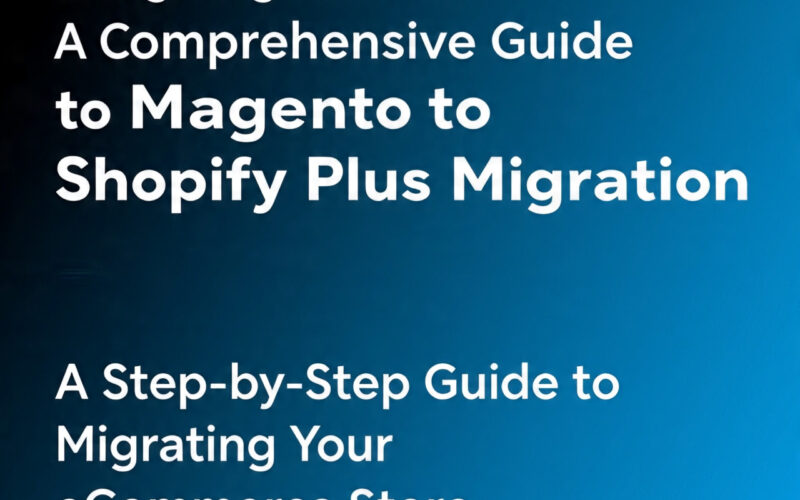In the rapidly evolving landscape of enterprise e-commerce, choosing the right platform can make or break your digital success. For many businesses running on Magento (now Adobe Commerce), the question isn’t whether to migrate, but when and how. As an e-commerce expert who has observed countless platform transitions, I’ve witnessed firsthand the transformative impact of strategic Magento to Shopify Plus Migration initiatives.
Why Enterprise Merchants Are Making the Move
The migration from Magento to Shopify Plus isn’t simply a trend. It’s a strategic response to fundamental shifts in how modern e-commerce operates. Magento, while powerful and highly customizable, often demands significant technical resources, ongoing maintenance, and complex infrastructure management. In contrast, Shopify Plus offers a managed SaaS solution that allows teams to focus on growth rather than technical overhead.
The driving factors behind migration typically include:
Operational Complexity vs. Simplicity
Magento’s open-source flexibility comes with a price: complexity. Many merchants find themselves spending disproportionate resources on server maintenance, security patches, and technical troubleshooting. Shopify Plus eliminates this burden through its fully managed infrastructure, allowing businesses to redirect technical resources toward innovation and customer experience.
Total Cost of Ownership
While Magento itself may be free (for the open-source version), the true cost encompasses hosting, development, maintenance, security, and specialized developer talent. These hidden costs can quickly escalate, particularly for mid-market businesses. Shopify Plus offers predictable, transparent pricing with enterprise-grade features included, making financial planning more straightforward.
Speed to Market
In today’s competitive landscape, agility matters. Shopify Plus enables faster deployment of new features, seamless integration with modern marketing tools, and rapid iteration on customer experience improvements. The platform’s extensive app ecosystem and built-in functionality reduce development time significantly compared to custom Magento implementations.
Scalability and Performance
Shopify Plus is built to handle high-volume traffic spikes without manual intervention. During peak shopping seasons like Black Friday or Cyber Monday, the platform automatically scales to accommodate demand—something that requires careful infrastructure planning with Magento.
Understanding the Migration Landscape
A successful Magento to Shopify Plus Migration requires more than simply transferring data from one platform to another. It demands strategic planning, careful execution, and a deep understanding of both platforms’ capabilities and limitations.
Key Considerations Before Migration
Data Audit and Mapping Begin with a comprehensive audit of your existing Magento store. This includes products, customer data, order history, reviews, CMS content, and metadata. Understanding what needs to migrate—and what can be sunset—is crucial for a clean transition. Data mapping between platforms requires attention to structural differences, particularly around product variants, custom attributes, and customer segmentation.
SEO Preservation One of the most critical aspects of any platform migration is maintaining search engine rankings and organic traffic. Your migration strategy must include comprehensive URL mapping, 301 redirects, and preservation of metadata. Shopify’s URL structure differs from Magento’s, making proper redirect planning essential. A well-executed migration maintains SEO equity; a poorly executed one can result in significant traffic loss that takes months to recover.
Custom Functionality Assessment Magento stores often contain extensive customizations—from checkout modifications to complex business logic. Not all custom functionality can or should be replicated in Shopify Plus. This phase requires honest evaluation: which customizations provide genuine business value, and which can be replaced with native Shopify Plus features or apps? In many cases, out-of-the-box Shopify Plus functionality can replace complex custom code with more maintainable solutions.
Integration Ecosystem Modern e-commerce operates through interconnected systems—ERP, CRM, marketing automation, inventory management, and more. Your migration plan must account for how these integrations will function post-migration. Shopify Plus offers robust API capabilities and a vast app marketplace, but integration architecture may differ significantly from your current Magento setup.
The Migration Process: A Strategic Framework
Phase 1: Planning and Preparation (4-6 weeks)
The foundation of successful migration lies in thorough planning. This phase involves:
- Stakeholder alignment on goals, timelines, and success metrics
- Detailed current-state analysis of your Magento implementation
- Future-state design for your Shopify Plus store
- Resource allocation and team formation
- Risk assessment and mitigation planning
Phase 2: Design and Development (6-8 weeks)
This phase brings your new Shopify Plus store to life:
- Theme development or customization that reflects your brand identity
- Feature implementation including checkout customization, customer accounts, and promotional capabilities
- Third-party integration setup and testing
- Content migration and optimization
- Custom app development if needed for specialized functionality
Working with experienced Shopify Plus designers like Netalico during this phase ensures your new store not only functions flawlessly but also delivers a compelling brand experience that drives conversions.
Phase 3: Data Migration and Testing (3-4 weeks)
The technical migration of data requires meticulous attention:
- Staged data migration beginning with products, followed by customers and orders
- Data validation to ensure accuracy and completeness
- Comprehensive testing including functionality, performance, and security
- User acceptance testing with key stakeholders
- Load testing to ensure the platform can handle your traffic volumes
Phase 4: Launch and Optimization (2-3 weeks)
The go-live process and immediate post-launch period:
- Final data synchronization to capture any recent changes
- DNS cutover and redirect implementation
- Launch monitoring with dedicated support during the transition
- Immediate issue resolution as they arise
- Performance monitoring and optimization
Common Challenges and How to Overcome Them
Data Complexity
Enterprise Magento stores often contain years of historical data with complex relationships. The solution lies in intelligent data migration strategies that prioritize critical information while archiving or cleaning outdated records. Working with experienced migration specialists who understand both platforms’ data structures can dramatically reduce complications.
Functionality Gaps
Not every Magento feature has a direct Shopify Plus equivalent. However, Shopify Plus offers its own powerful features—like Shopify Flow for automation, Launchpad for event management, and Scripts for checkout customization—that often provide superior solutions to Magento customizations. The key is approaching migration as transformation rather than mere replication.
Team Learning Curve
Your team’s familiarity with Magento won’t automatically translate to Shopify Plus expertise. Build in time for training and documentation. The good news? Shopify Plus’s intuitive interface typically requires less technical knowledge than Magento, empowering more team members to contribute to store management.
Downtime Concerns
With careful planning, migration downtime can be minimal. Strategies include staging the new site on Shopify Plus for complete testing before cutover, timing the migration during low-traffic periods, and implementing comprehensive redirect strategies to ensure no customer journey is interrupted.
Post-Migration: Maximizing Your Investment
Migration is not the finish line—it’s the starting point for optimization. Post-migration focus areas include:
Performance Optimization Leverage Shopify Plus’s speed and reliability while fine-tuning for your specific use case. This includes image optimization, app performance review, and conversion rate optimization.
Feature Adoption Many businesses initially replicate their Magento functionality but gradually adopt native Shopify Plus features that provide better solutions. This includes using Shopify Flow for automation, embracing the newer checkout extensibility options, and leveraging Shopify’s native marketing features.
Continuous Improvement Shopify Plus’s rapid release cycle means new features and capabilities regularly become available. Stay informed about platform updates and continuously evaluate how new functionality can benefit your business.
Choosing the Right Migration Partner
While technically possible to self-migrate, partnering with experienced specialists significantly reduces risk and accelerates time-to-value. Look for partners who:
- Demonstrate deep expertise in both Magento and Shopify Plus architectures
- Have a proven methodology with documented success stories
- Provide comprehensive support beyond just technical migration
- Understand your industry’s specific requirements
- Offer post-launch support and optimization services
A strategic Magento to Shopify Plus Migration represents more than a platform change. It’s an opportunity to reimagine your e-commerce operation for greater efficiency, agility, and growth potential.
The Bottom Line
As enterprise e-commerce continues to evolve, the platforms that power online business must evolve with it. For many Magento merchants, migration to Shopify Plus offers a path to reduced complexity, lower total cost of ownership, and enhanced agility in an increasingly competitive market.
Success requires treating migration as a strategic initiative rather than a purely technical project. With proper planning, experienced partners, and a commitment to transformation rather than mere replication, businesses can emerge from migration not just with a new platform, but with a stronger foundation for sustainable e-commerce growth.
The question isn’t whether Shopify Plus can support your enterprise needs—thousands of high-growth brands have proven it can. The question is whether you’re ready to embrace a platform philosophy that prioritizes speed, simplicity, and scalability over complexity. For businesses prepared to make that shift, the rewards can be transformative.
About the Migration Journey
Every business’s migration story is unique, shaped by specific technical requirements, business objectives, and organizational readiness. Whether you’re just beginning to explore platform options or actively planning your transition, understanding the full scope of migration helps set realistic expectations and positions your initiative for success. The investment in strategic planning and expert guidance pays dividends in reduced risk, faster time-to-value, and a stronger competitive position in the digital marketplace.




